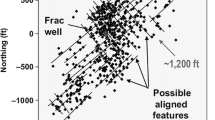Abstract
In order to fracture shale gas reservoir with carbon dioxide as the working fluid, laboratory experiments were firstly conducted to measure the influence of carbon dioxide immersion on shale rock’s properties, and then the coupling mechanism between stress and seepage during hydraulic fracturing was simulated based on cohesive zone model. The fracturing ability of carbon dioxide and water was also compared under the same working conditions, and finally sensitivity analysis (including elastic modulus of shale, filtration coefficient, pump rate and viscosity of carbon dioxide) were conducted based on field application. The results show that, the elastic modulus of shale increased by 32.2%, the Poisson's ratio decreased by 40.3% and the compressive strength decreases by 22.9% after geothermal reaction with carbon dioxide under 30 MPa and 335.15 K for 2 hours. Compared with water fracturing, carbon dioxide fracturing induces longer fracture (increased by 25.3%) and narrower fracture (decreased to 40.8%). The fracture tends to get longer and narrower with increasing elastic modulus of shale. As filtration coefficient increases, the maximum width of fracture decreases significantly, whereas the length changes little. Both the length and maximum width of fracture increase with increasing pump rate, however the changing rate of length tends to decrease. The influence of viscosity of carbon dioxide on both fracture width and length is negligible, which validates the stable feasibility of carbon dioxide fracturing in different formation conditions.
Similar content being viewed by others
References
Weijermars R., Economic appraisal of shale gas plays in Continental Europe. Applied Energy, 2013, 106: 100–115.
Xue Q., Leung H., Huang L., et al., Modeling of torsional oscillation of drillstring dynamics. Nonlinear Dynamics, 2019, 96: 267–283.
Middleton R.S., Carey J.W., Currier R.P., et al., Shale gas and non-aqueous fracturing fluids: Opportunities and challenges for supercritical CO2. Applied Energy, 2015, 147(3): 500–509.
Soni T.M., LPG-Based Fracturing: An alternate fracturing technique in shale reservoirs. SPE paper 170542, 2014.
Hall M., Kilpatrick J.E., Surface microseismic monitoring of slick water and nitrogen fracture stimulations, Arkoma Basin, Oklahoma. SPE paper 132371, 2010.
Sun B., Zhang Y., Du Q., et al., Property evaluation of CO2 adsorption and desorption on shale. Journal of China University of Petroleum (Edition of Natural Science), 2013, 37(5): 95–99.
Song W., Zhang J., Wang C., et al., Flow field characters near fracture entrance in supercritical carbon dioxide sand fracturing. Greenhouse Gases: Science and Technology, 2019, 9(5): 999–1009.
Sun X., Ni H., Qiao H., et al., Experimental study on the mechanism of carbon dioxide removing formation paraffin deposits. Journal of Natural Gas Science & Engineering 2016, 32: 59–66.
Gong L., Chen S., and Zuo J., et al., Phase prediction of supercritical carbon dioxide and its application in fracturing oil wellbores. Journal of Thermal Science, 2019, 28(3): 484–493.
Ni H., Song W., Wang R., et al., Coupling model for carbon dioxide wellbore flow and heat transfer in coiled tubing drilling. Journal of Natural Gas Science & Engineering, 2016, 30: 414–420.
Sun B., Sun W., Research progress and prospectives of supercritical CO2 thickening technology. Journal of China University of Petroleum (Edition of Natural Science), 2015, 39(3): 76–83.
Hou L., Sun B., Wang Z., et al., Experimental study of particle settling in supercritical carbon dioxide. Journal of Supercritical Fluids, 2015, 100: 121–128.
Song W., Ni H., Wang R., et al., Pressure transmission in the tubing of supercritical carbon dioxide fracturing. Journal of CO2 Utilization, 2017, 21: 467–472.
Fenghour A., Wakeham W.A., The viscosity of carbon dioxide. Journal of Physical and Chemical Reference Data, 1998, 27(1): 31–44.
Zhang R., Xiong Y., Winterfeld P.H., et al., A novel computational framework for thermal-hydrological-mechanical-chemical processes of CO2 geological sequestration into a layered saline aquifer and a naturally fractured enhanced geothermal system. Greenhouse Gas Science & Technology, 2016, 6(3): 370–400.
Li M., Ni H., Xiao C., et al., Influences of supercritical carbon dioxide jets on damage mechanisms of rock. Arabian Journal for Science & Engineering, 2018, 43(5): 2641–2658.
Wen H., Chen M., Jin Y., et al., A chemo-mechanical coupling model of deviated borehole stability in hard brittle shale. Petroleum Exploration and Development, 2014, 41(6): 748–754.
Lv Q., Long X., Ranjith P., et al., Unconventional gas: experimental study of the influence of subcritical carbon dioxide on the mechanical properties of black shale. Energies, 2016, 9(7): 516–530.
Yin H., Zhou J., Xian X., et al., Experimental study of the effects of sub- and super-critical CO2 saturation on the mechanical characteristics of organic-rich shales. Energy, 2017, 132: 84–95.
Zhang S., Xian X., Zhou J., et al., Mechanical behaviors of Longmaxi black shale saturated with different fluids: An experimental study. RSC Advances, 2017, 7: 42946–42955.
ZHANG G., A numerical simulation study on hydraulic fracturing of horizontal wells. Hefei: University of Science and Technology of China, 2010.
Malvern L.E., Introduction to the mechanics of continuous medium. Englewood cliffs: Prentice-Hall, Inc, 1969, pp. 423–434.
Stagg K.G., Zienkiewicz O.C., Rock mechanics. Wales: University of Wales, Swansea, 1979: 55–62.
Hagoort J., Weatherill D.B., Settari A., Modeling the propagation of waterflood-induced hydraulic fractures. SPE Paper 7412, 1980.
Wang Z., Feature research of supercritical carbon dioxide drilling fluid. China University of Petroleum, Qingdao, China, 2008.
Du Q., Optimization design of the hydraulic parameters for supercritical carbon dioxide fracturing. China University of Petroleum, Qingdao, China, 2014.
Wang X., Numerical simulation of hydraulic fracturing and the pattern of fracture propagation in coal reservoirs. China University of Geoscience, Beijing, China, 2011.
Acknowledgments
The financial supports from Natural Science Foundation of China (51974173), the Opening Fund of Key Laboratory of Mining Disaster Prevention and Control (MDPC201908) and Key Laboratory of Unconventional Oil & Gas Development (China University of Petroleum (East China)), Ministry of Education are highly appreciated.
Author information
Authors and Affiliations
Corresponding author
Rights and permissions
About this article
Cite this article
Song, W., Ni, H., Tang, P. et al. Simulation of Supercritical Carbon Dioxide Fracturing in Shale Gas Reservoir. J. Therm. Sci. 30, 1444–1451 (2021). https://doi.org/10.1007/s11630-021-1477-5
Received:
Published:
Issue Date:
DOI: https://doi.org/10.1007/s11630-021-1477-5




